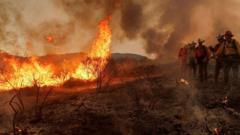A quickly spreading wildfire northwest of Los Angeles has ignited a state of urgency, prompting thousands of residents to evacuate as extreme temperatures and dry conditions worsen firefighting efforts. Known as the Canyon Fire, this blaze ignited Thursday afternoon along the Ventura-Los Angeles county border and has ballooned from an initial 30 acres to nearly 5,000 acres by Friday morning.
Authorities issued mandatory evacuations for over 2,700 residents, with an additional 14,000 individuals receiving evacuation warnings, according to the Ventura County Fire Department. The fire is 25% contained as of Friday, with hopes for improved containment notwithstanding the troublesome weather forecast, which predicts temperatures could soar to 100°F (37.7°C) in the days to come.
Santa Clarita, located close to the fire's path, is on high alert. City officials have urged all nearby residents to evacuate promptly if advised. "The #CanyonFire is spreading fast under extreme heat & dry conditions," said LA County Supervisor Kathryn Barger, stressing that residents should take evacuation orders seriously.
Fortunately, as of Thursday evening, there have been no reports of injuries or damage to homes, according to the LA County Fire Department. However, the Canyon Fire is not an isolated event; multiple active wildfires are currently raging across California. The Gifford Fire, which has burned nearly 100,000 acres and spans San Luis Obispo and Santa Barbara counties, stands as the largest active blaze in the state.
Wildfires have become increasingly frequent in California, attributed largely to climate change, which has resulted in hotter, drier conditions contributing to longer, more destructive fire seasons. The January Eaton Fire serves as a tragic reminder of these dangers, having claimed at least 31 lives and devastated numerous structures in the Altadena neighborhood near Los Angeles.
As the state grapples with these environmental challenges, studies suggest that there have been more than 400 indirect deaths linked to wildfires in Los Angeles, underscoring the far-reaching ramifications of such disasters. The growing frequency of these fires reveals an urgent call for climate-focused innovations in emergency preparedness and response.



















